Lucas van Leyden
Lucas van Leyden (1494 – 8 August 1533), also named either Lucas Hugensz or Lucas Jacobsz, was a Dutch painter and printmaker in engraving and woodcut. Lucas van Leyden was among the first Dutch exponents of genre painting and was a very accomplished engraver.[1]
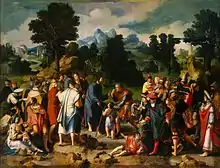
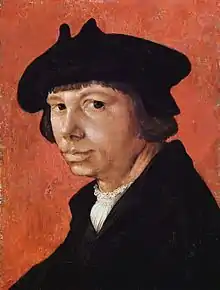
Lucas was the son of the painter Huygh Jacobsz. He was born, died, and was mainly active in Leiden.
Carel van Mander characterizes Lucas as a tireless artist, who as a child annoyed his mother by working long hours after nightfall, which she forbade not only for the cost of candlelight, but also because she felt that too much study was bad for his sensibilities. According to Van Mander, as a boy he only consorted with other young artists, such as painters, glass-etchers and goldsmiths, and was paid by the Heer van Lochorst (Johan van Lockhorst of Leiden, who died in 1510) a golden florin for each of his years at age 12 for a watercolor of St. Hubert.[2]
Paintings
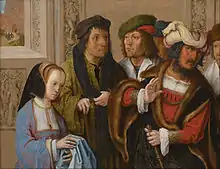
He learned basic techniques from his father[3] and from Cornelis Engelbrechtsz, but his precocious originality was paramount. Where he learnt engraving is unknown, but he took advantage of the works of Marcantonio Raimondi, whose motifs are reworked in Lucas' engravings and paintings, and became highly skilled in that art at a very early age: the earliest known print by him (Mohammed and the Murdered Monk) dates from 1508, when he was perhaps only 14, yet reveals no trace of immaturity in inspiration or technique.
Seventeen paintings surely by Lucas survive, and a further twenty-seven are known from descriptions by Carel van Mander, from contemporary copies or from drawings of them made by Jan de Bisschop in the later 17th century.[4] Max Friedländer[5] descried no clear pattern of stylistic development, in large part because Lucas' oeuvre was swelled and obscured by attributions since found unsustainable.
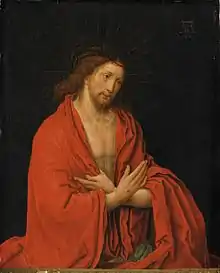
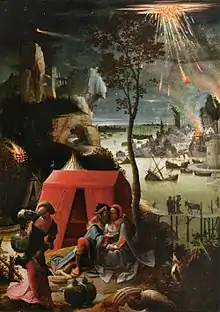
Four broad stages in his artistic development are characterized by Elise Lawton Smith as his early half-length figures (c 1506–1512), the development of his landscapes (c 1512–1520), the influence of Antwerp paintings (c 1521–25) and the late works (ca 1525–1531), where multiple figures are deployed against wooded landscapes, as in the Healing of blind man of Jericho (illustration).
Raimondi's studies of nudes inspired van Leyden in his later work, particularly his altarpieces, in which he is an early Dutch adopter of the Italian-style nude figure. Two further artistic influences were Albrecht Dürer and Jan Gossaert. Indeed, he was friends with both, and Dürer drew van Leyden's portrait when they met in 1521. Dürer's mastery of engraving and Gossaert's Romanist style both heavily influenced van Leyden's work.[6]
- Lucas van Leyden's works -paintings
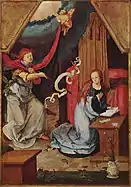 Annunciation 1522
Annunciation 1522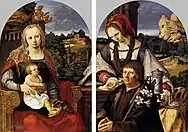 Virgin and Child with Mary Magdalen and a donor. 1522
Virgin and Child with Mary Magdalen and a donor. 1522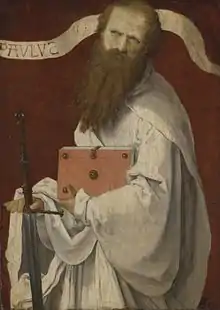 Saint Paul, attr. Leyden
Saint Paul, attr. Leyden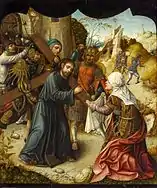 Bearing of the Cross with Veronica, 1520s
Bearing of the Cross with Veronica, 1520s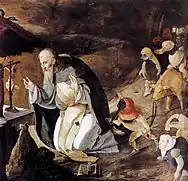 The Temptation of St Anthony
The Temptation of St Anthony Card Players
Card Players The Last Judgement
The Last Judgement
- Engravings
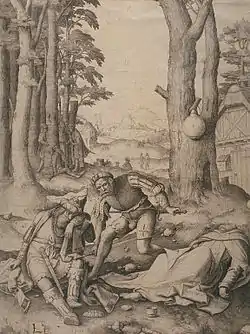 Mohammed and the murdered monk 1508
Mohammed and the murdered monk 1508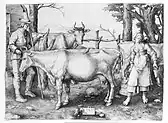 The Milkmaid, engraving, 1510
The Milkmaid, engraving, 1510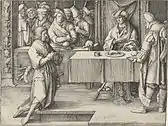 Joseph Explains Pharaoh's Dream, engraving, 1512
Joseph Explains Pharaoh's Dream, engraving, 1512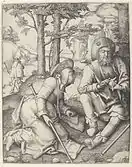 Resting Pilgrims
Resting Pilgrims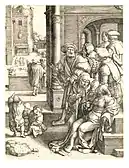 Virgil in a Basket, 1525
Virgil in a Basket, 1525
Prints
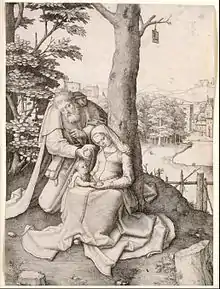
Lucas's print included secular subjects, and many depictions of famous Biblical scenes, including Adoration of the Magi, The Virgin and Child on the Crescent, and The Holy Family.
The Power of Women Series
From 1513 to 1517, Lucas created a series of woodcuts called "The Power of Women", which consisted of two large and small sets of prints.[7] The series is one of a number of representations of the Power of Women theme, which was extremely popular in Renaissance art and literature. Artworks in the genre depict the traditional roles of men and women in inverse, with women dominating over men in various situations. The subjects illustrated often consist of legendary historical women who were considered to be virtuous heroines as well as women who were considered cunning, seductive, and manipulative of men. The purpose of the "Power of Women" theme was to demonstrate that even the strongest and wisest of men were not resistant to the sexuality of women.[8]
Large Power of Women (1513—)
The Mouth of Truth: A woman kneels in front of the Emperor of Rome and places her hand in the mouth of a statue of a lion while a crowd observes in the background.[9]
The Fall of Man: In the foreground, Eve stands to the left of the tree of knowledge of good and evil, around which a serpent is wrapped, and hands an apple to Adam, who sits to the right of the tree. In the background to the right, an angel drives Adam and Eve out of Eden.[10]
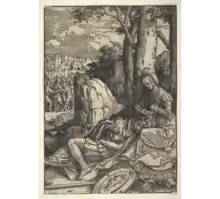
Samson and Delilah: Delilah sits a bed of rocks while Samson lies sleeping in her lap. She holds his hair in one hand and cuts it with a knife.[11]
Solomon's Idolatry: King Solomon kneels in front of an idol of Moloch in the center foreground while one of his mistresses and a crowd of men observe him from behind.[12]
Herod and Herodias: Herod and Herodias sit at a table while their daughter Salome approaches them, holding a plate bearing the head of St. John the Baptist.[13]
The Poet Virgil Suspended in a Basket: Virgil is shown stranded in a basket hung on the side of a tower in the town square, with a jeering crowd below him.[14]
Small Power of Women (1517—)
The Fall of Man: In the foreground, Adam and Eve are around the tree of knowledge of good and evil, with the serpent wrapped around the trunk and holding an apple. In the background, an angel drives Adam and Eve out of paradise.[15]

Jael Killing Sisera: In the foreground, Jael hammers a tent peg into Sisera's ear as he lies on the ground. In the middle ground on the right, Jael points out the foreground scene to a group of armed Israelites. In the background on the left, Sisera drinks from a goblet given to him by Jael.[16]
Samson and Delilah: Same as woodcut of larger size. Delilah sits a bed of rocks while Samson lies sleeping in her lap. She holds his hair in one hand and cuts it with a knife.[11]
Solomon's Idolatry: Same as woodcut of larger size. King Solomon kneels in front of an idol of Moloch in the center foreground while one of his mistresses and a crowd of men observe him from behind.[12]
Jezebel Promising Naboth's Vineyards to King Ahab: Jezebel stands beside her husband King Ahab of Israel, who is lying on his bed in his room.[17]
Herod and Herodias: In the foreground, Salome holds a plate bearing the head of St. John the Baptist in front of Herod and Herodias, who are sitting at a table. Through a window on the back wall, St. John the Baptist is seen being beheaded.[18]
- Power of Women Woodcuts
 The Fall of Man (Large Power of Women)
The Fall of Man (Large Power of Women)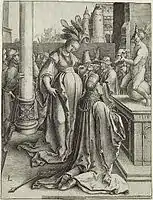 Solomon's Idolatry
Solomon's Idolatry Herod and Herodias (Large Power of Women)
Herod and Herodias (Large Power of Women) The Poet Virgil Suspended in a Basket
The Poet Virgil Suspended in a Basket The Fall of Man (Small Power of Women)
The Fall of Man (Small Power of Women)
Family
In 1515, Lucas married Elisabeth van Boschhuysen, from a patrician Leiden family. The marriage remained childless. Lucas did have a daughter Marijtje, born in Leiden out of wedlock around 1512. This daughter Marijtje would later marry the painter Dammas Claesz de Hoij. In their offspring, the De Hoij family, one can find prominent artists throughout the sixteenth and seventeenth centuries.
See also
Notes
- The modern monograph is Elise Lawton Smith, The Paintings of Lucas van Leyden: a new appraisal, with catalogue raisonné, 1992.
- (in Dutch) Lucas van Leyden biography in Karel van Mander's Schilderboeck, 1604, courtesy of the Digital library for Dutch literature
- Smith 1992 identifies Huygh Jacobsz with the pseudonymous Master of the St John Panels.
- Smith 1992.
- Friedländer, Lucas van Leyden, 1924.
- "Lucas van Leyden | Dutch artist". Encyclopedia Britannica. Retrieved 23 October 2018.
- Hollstein, Friedrich. W. H. (1993). "The New Hollstein: Dutch and Flemish etchings, engravings and woodcuts 1450–1700". The British Museum.
- http://ir.uiowa.edu/cgi/viewcontent.cgi?article=1410&context=mff%7Ctitle
- "The Large Power of Women Series". The British Museum.
- "The Large Power of Women Series". British Museum. Retrieved 19 June 2017.
- "Lucas van Leyden | Samson and Delilah | The Met". The Metropolitan Museum of Art, i.e. The Met Museum. Retrieved 19 June 2017.
- "Solomon's Idolatry | The Art Institute of Chicago". www.artic.edu. Retrieved 19 June 2017.
- Lucas van Leyden (c. 1512), Herod and Herodias, retrieved 19 June 2017
- "The Poet Virgil Suspended in a Basket (Block 6 from a series of 6 , The "large" Power of Women)". Museum of Fine Arts, Boston. 27 April 2016. Archived from the original on 7 March 2017. Retrieved 19 June 2017.
- "The Small Power of Women Series". British Museum. Retrieved 19 June 2017.
- "Lucas van Leyden | Jael Killing Sisera, without ornamental frame | The Met". The Metropolitan Museum of Art, i.e. The Met Museum. Retrieved 19 June 2017.
- "Lucas van Leyden | Jezebel Promising Naboth's Vineyards to King Ahab | The Met". The Metropolitan Museum of Art, i.e. The Met Museum. Retrieved 19 June 2017.
- "The Small Power of Women Series". British Museum. Retrieved 19 June 2017.
External links
![]() Media related to Lucas van Leyden at Wikimedia Commons
Media related to Lucas van Leyden at Wikimedia Commons
- Prints & People: A Social History of Printed Pictures, an exhibition catalog from The Metropolitan Museum of Art (fully available online as PDF), which contains material on Lucas van Leyden (see index)
- Works by Lucas van Leyden at the Museum of New Zealand Te Papa Tongarewa
- Literature on Lucas van Leyden